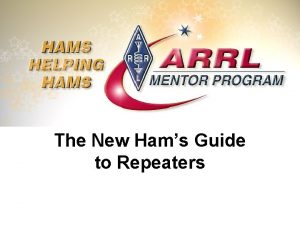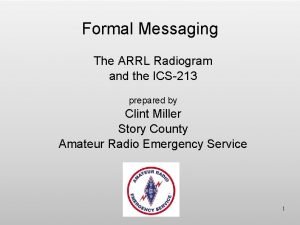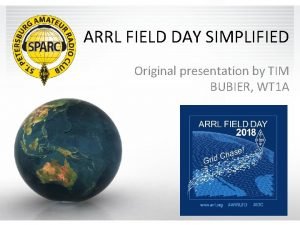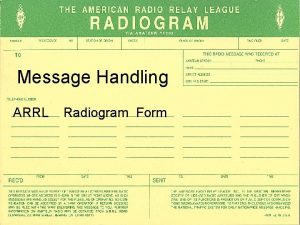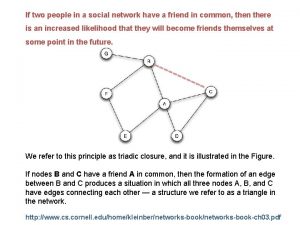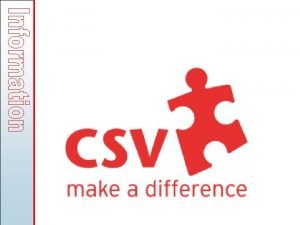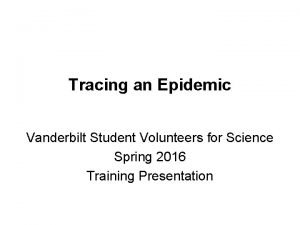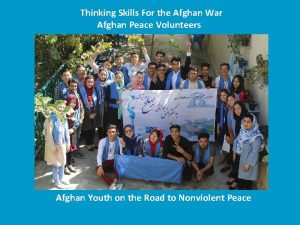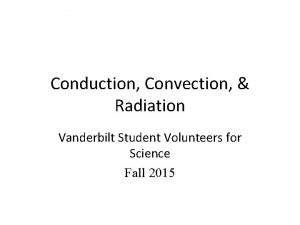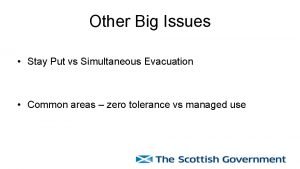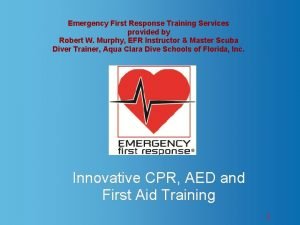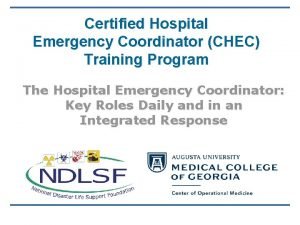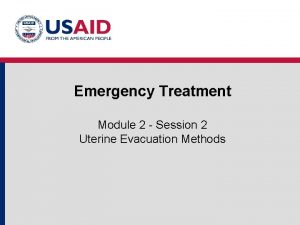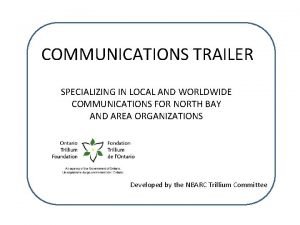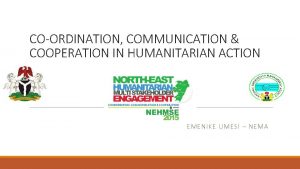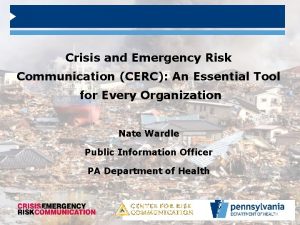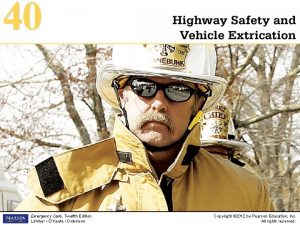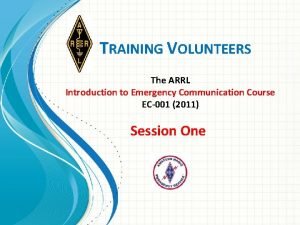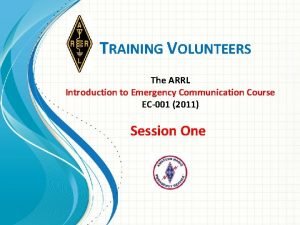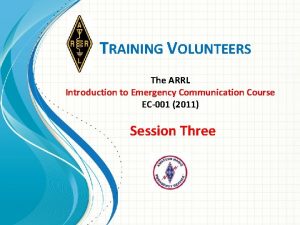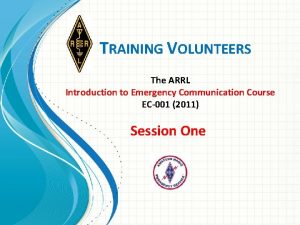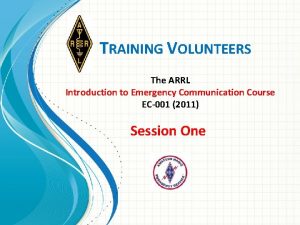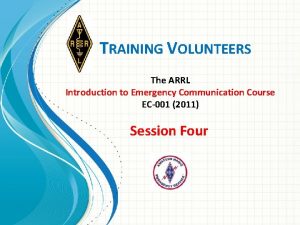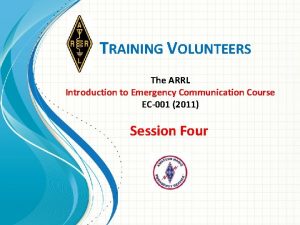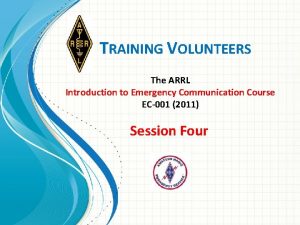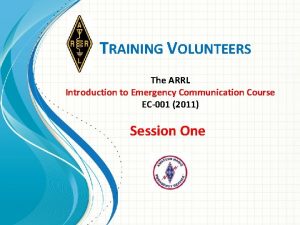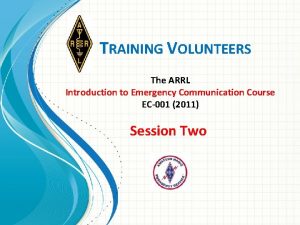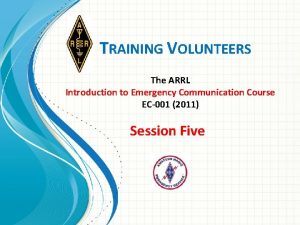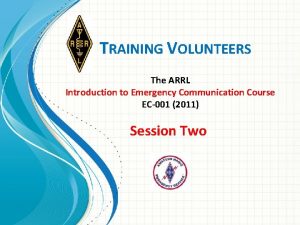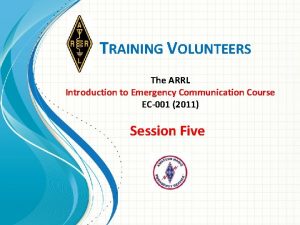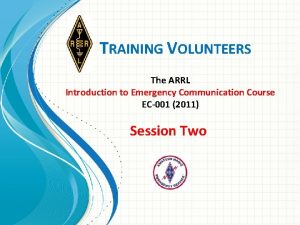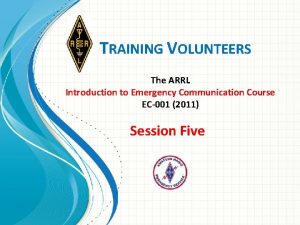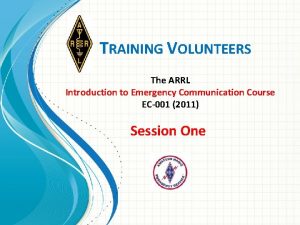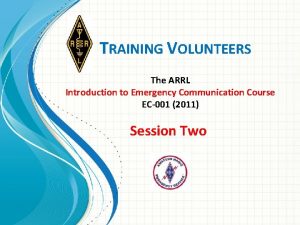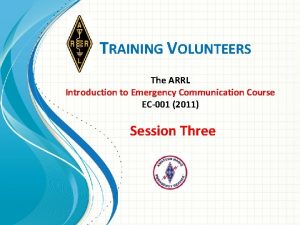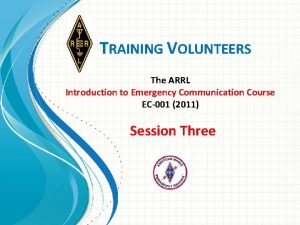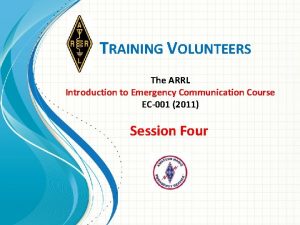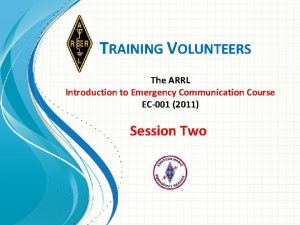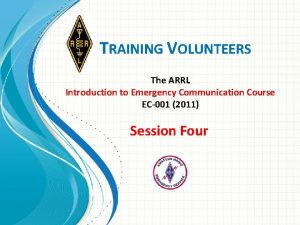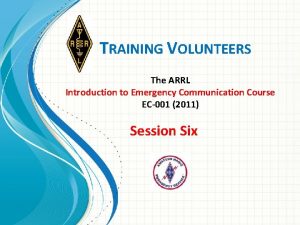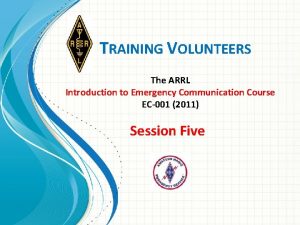TRAINING VOLUNTEERS The ARRL Introduction to Emergency Communication

























- Slides: 25

TRAINING VOLUNTEERS The ARRL Introduction to Emergency Communication Course EC-001 (2011) Session Five

Reminder • Complete two DHS/FEMA Courses • IS-100. b Introduction to ICS • IS-700 National Incident Management System Http: //training. fema. gov/IS/NIMS. asp

Session Five Topic Session 1 – Topics 1, 2, 3, 4, 5 a, 5 b Session 2 – Topics 6, 7 a, 7 b, 7 c, 7 d, 8, 9, 10 Session 3 – Topics 11, 12, 13, 14, 15 Session 4 – Topics 16, 17, 18, 19, 20 Session 5 – Topics 21, 22, 23, 24, 25, 26, 27 Session 6 – Topics 28, 29, Summary, Final Exam

Topic 25 – What to Expect in Large. Scale Disasters

At The Onset: Critical Communication Requirements In a Disaster • Huge increase in the volume of traffic on public-safety radio channels, accompanied by prolonged waiting periods to gain access • Equipment outages occur at key locations • Messages are not handled in order of priority • Urgent messages are often lost • Need arises for agencies to communicate with one another – Incompatible radio systems – Unfamiliar or unattainable frequencies, names, terms, and procedures

At The Onset: Critical Communication Requirements in a Disaster • Large-scale situation – Contact locations at distances beyond the range of a given radio or system (50 to 350 miles or more) • Message reply delays are experienced – Deferred decisions on crucial matters – Message duplication – Confusion • Messages with widely differing priorities

Different modes of communication • Different modes of communication are required in addition to voice – Volume data in printed form data modes, high-speed packet, and facsimile – Morse code or PSK 31 under difficult reception conditions – Encoded data for extreme privacy – Television--mobile, portable, aeronautical, and marine – Telephone interconnections from/to radio systems

Operational Problems Arise • High-volume traffic circuits with no supply of message forms • Using the only printed forms available that were designed for a different, unrelated agency or function • Attempting to decipher scribbling from untrained message writers; using scribes who cannot understand radio parlance or read through QRM • Becoming inundated with traffic volume so heavy it results in confusion over which messages are to be sent, which were sent, which have been received for delivery, and which have been received to be filed for ready reference.

What Happens in the First 72 Hours? • Takes time to overcome the obstacles to placing fully activated mutual aid resources into operation • Greatest concentration of relief effort – Generally found in the incorporated cities served by agencies with paid professionals • Assuming their equipment, facilities and personnel remain operable • Suburbs and isolated areas of a county – Suffer from remoteness from fire departments, public works, law enforcement and the services of all other agencies

What Happens in the First 72 Hours? • The public is often isolated, unable to call for help or determine the nature and extent of the disaster • Should they make plans to: – "Wait it out. " – Prepare to evacuate. – Actually evacuate with some possessions to a safe place – Obtain physical aid for an impending catastrophe – Offer aid to a relative, friend or neighbor • Lack of information results in further attempted use of the telephone when the system is already saturated

What Happens in the First 72 Hours? • The opportunity to call for help is often unavailable to most citizens during the first 72 hours http: //www. 3 days 3 ways. org

What Happens in the First 72 Hours? • Distorted public perceptions develop through misinformation • Broadcast stations (those still on the air) initially disseminate rumors in the absence of factual information • People walk aimlessly seeking a route to family and friends • Many, fearful of looting, remain in hazardous buildings, or return, as do shopkeepers, to salvage valuables • As darkness falls, rumors of looting are generated some true

What Happens in the First 72 Hours? • Word circulates about shelter locations • Some displaced persons stay at homes of friends, relatives or strangers – Others are housed at public shelters into the fourth day, still searching for family members elsewhere, and without communication • Opportunity to notify concerned distant relatives is not afforded except via Amateur Radio and the American Red Cross

What Happens in the First 72 Hours? • Later, often too late, information trickles in about problem areas or cases that have been overlooked due to the lack of communication • Some potential evacuees are overlooked • Survival instincts prevail • Inter-agency communication is poor to non-existent • At the end of 72 hours, the disaster area remains in virtual isolation except for helicopter service for known critical cases and official use

What Happens in the First 72 Hours? • Amateur Radio operators from neighboring counties and states offer to help but are often unable to cross the roadblocks established to limit access by sightseers and potential looters • Disorganized local volunteers often lack essential skills and orientation • Costly mistakes are made and systems bog down

What Happens in the First 72 Hours? • The dead pose a serious health problem. • Stress rises among the citizenry. • Little overall assessment emerges in the first 72 hours about available emergency resources and relief supplies. • Shortages are apparent and growing • Travel continues to be difficult and slow • Relief supplies trickle in to uncertain storage locations

What Happens in the First 72 Hours? • Food and water shortages have become critical • Normal water sources may have been cut off or contaminated • Relief efforts are mounted when someone takes charge, makes a decision, and directs the efforts of others. • The command control process of directing requires communication - the ingredient in short supply in all disasters

What Happens in the First 72 Hours? • At the critiques following a disaster, as always, the cry is heard: "Next time we must be better prepared!" A committee is formed and it all starts over

Summary • Any questions before the quiz?

Topic 25 Question 1. What is the first thing that happens after a disaster has occurred? A. The Federal Emergency Management Agency arrives on the scene B. The Red Cross and Salvation Army arrive with food and bedding for victims C. Massive increase in the volume of traffic on public-safety radio channels D. The press provides up to date and accurate information to the public

Topic 25 Question 2. Which of the following statements is NOT true of interagency communication? A. Many agencies use incompatible radio systems B. Many agencies are reluctant to use each other's radio system C. Agencies all use the same radio systems and frequencies D. Amateur Radio can be used to link agencies

Topic 25 Question 3. In the first 72 hours of a disaster situation, where is the greatest concentration of relief effort to be found? A. B. C. D. Urban areas Suburban areas Rural areas Outside the affected area

Topic 25 Question 4. Which organization handles health and welfare messages on behalf of the victims? A. B. C. D. Department of Homeland Security Hurricane Watch Net National Weather Service American Red Cross

Topic 25 Question 5. What is the usual situation in a disaster after the initial 72 hours? A. The disaster area remains in virtual isolation B. The disaster is over and everybody can go home C. A few victims still need assistance D. Communication systems are back to normal

ANY QUESTIONS BEFORE STARTING TOPIC 26?
 Arrl travel plus
Arrl travel plus Arrl radiogram
Arrl radiogram Arrl logbook
Arrl logbook Arrl field day
Arrl field day Arrl radiogram
Arrl radiogram Logbook of the world
Logbook of the world Arrl grounding and bonding pdf
Arrl grounding and bonding pdf Survey questions for volunteers
Survey questions for volunteers Bharat nirman volunteers
Bharat nirman volunteers Literacy volunteers
Literacy volunteers National community service
National community service Working together rafael and salvador
Working together rafael and salvador Dog trust basildon
Dog trust basildon Vanderbilt student volunteers for science
Vanderbilt student volunteers for science Afghan peace volunteers
Afghan peace volunteers Vanderbilt vsvs
Vanderbilt vsvs Dealing with troublesome volunteers
Dealing with troublesome volunteers What is simultaneous evacuation
What is simultaneous evacuation The importance of training
The importance of training Certified hospital emergency coordinator
Certified hospital emergency coordinator Emergency evacuation training
Emergency evacuation training Communications trailer
Communications trailer Communication coordination cooperation during the emergency
Communication coordination cooperation during the emergency Crisis and emergency risk communication
Crisis and emergency risk communication Introduction to emergency medical care
Introduction to emergency medical care Introduction to emergency medical care
Introduction to emergency medical care
